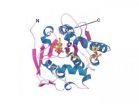(Press-News.org) (Boston) – Some infants born with neonatal abstinence syndrome (NAS) secondary to in-utero opioid exposure have a more difficult time going through withdrawal than others, but the underlying reasons are not well understood. While genetic and epigenetic (when genes are turned on or off) changes have recently been identified as potential factors, researchers at Boston University School of Medicine (BUSM) and Boston Medical Center (BMC) conducted a first of its kind study to identify some of these epigenetic changes that may influence symptom severity.
The researchers focused on how exposure to opioids such as methadone or subutex may alter expression of the mu-opioid receptor (OPRM1) gene, which is known as a primary site of action for narcotics in the nervous system and plays an important role in opioid dependent adults.
Looking at data from 86 infants whose mothers took either methadone or subutex during pregnancy, the results showed that infants with higher levels of the DNA modification called DNA methylation had more severe NAS symptoms. This meant that they required more medication(s) over a longer period of time to get through withdrawal. The researchers hypothesize that this may be due to a decrease in number of opioid receptors due to the silencing of the OPRM1 gene.
Future research in this area will focus on comparing methylation levels of mothers and infants to evaluate if the epigenetic changes are passed on from mother to child. The implications are that this very early in-utero and neonatal exposure to opioids may lead to lasting epigenetic changes that may alter one's future sensitivity to opioid and other addictive medications.
"What makes these results so intriguing is that these epigenetic changes could be passed on from mother to child, resulting in these children potentially having future issues and sensitivities around opioid and other addictive substances," said Elisha Wachman, MD, a staff neonatologist at BMC and assistant professor of pediatrics at BUSM.
INFORMATION:
This study is published in the Journal of Pediatrics and was supported in part by the National Institutes of Health under notice of grant award numbers DA024806-01A2, R01DA032889-01A1, DA018197-05 and DA026120; the Tufts Medical Center Natalie Zucker and Susan Saltonstall Grants; the National Center for Advancing Translational Sciences; the Toomim Family Fund; the Boston University Genome Science Institute; and the Alpert Foundation.
-30-
In-utero methadone, Subutex exposure could alter gene expression, cause severe Neonatal Abstience Syndrome
2014-08-19
ELSE PRESS RELEASES FROM THIS DATE:
Novel oral anticoagulant prescriptions soar, but at a high cost
2014-08-19
Philadelphia, PA, August 19, 2014 – Warfarin, the longtime standard treatment for atrial fibrillation, is facing competition from new options in the anticoagulant drug marketplace including dabigatran, rivaroxaban, and apixaban. A new study documents the rapid adoption of these novel oral anticoagulants (NOACs) into clinical practice. By mid-2013 NOACs accounted for 62% of all new anticoagulant prescriptions yet this represents 98% of total anticoagulant-related drug costs. Findings are published in The American Journal of Medicine.
Atrial fibrillation (AF) is a serious ...
Markey researchers develop web-based app to predict glioma mutations
2014-08-19
new web-based program developed by University of Kentucky Markey Cancer Center researchers will provide a simple, free way for healthcare providers to determine which brain tumor cases require testing for a genetic mutation.
Gliomas – a type of tumor that begins in the brain or spine – are the most common and deadly form of brain cancer in adults, making up about 80 percent of malignant brain cancer cases. In some of these cases, patients have a mutation in a specific gene, known as an IDH1 mutation – and patients who have this tend to survive years longer than those ...
Philippine tarsier gets boost from Kansas research, and genetic proof of a new variety
2014-08-19
LAWRENCE — It's not a monkey. It's not a lemur. It's not an African Bush Baby or even a Madagascan Mouse. Meet the Philippine tarsier: a tiny, adorable and downright "cool" primate from Southeast Asia.
"It's really not like any animals that Americans are familiar with," said Rafe Brown, curator-in-charge at the University of Kansas' Biodiversity Institute. "A tarsier has giant eyes and ears; an extremely cute, furry body; a long tail with a furry tuft at the end; and interesting expanded fingers and toe tips that look a bit like the disks on the digits of tree frogs."
Brown ...
New vaccine shows promise as stronger weapon against both tuberculosis and leprosy
2014-08-19
In many parts of the world, leprosy and tuberculosis live side-by-side. Worldwide there are approximately 233,000 new cases of leprosy per year, with nearly all of them occurring where tuberculosis is endemic.
The currently available century-old vaccine Bacille Calmette-Guerin, or BCG, provides only partial protection against both tuberculosis and leprosy, so a more potent vaccine is needed to combat both diseases. UCLA-led research may have found a stronger weapon against both diseases.
In a study published in the September issue of the peer-reviewed journal Infection ...
Seafood substitutions can expose consumers to unexpectedly high mercury
2014-08-19
New measurements from fish purchased at retail seafood counters in 10 different states show the extent to which mislabeling can expose consumers to unexpectedly high levels of mercury, a harmful pollutant.
Fishery stock "substitutions"—which falsely present a fish of the same species, but from a different geographic origin—are the most dangerous mislabeling offense, according to new research by University of Hawai'i at Mānoa scientists.
"Accurate labeling of seafood is essential to allow consumers to choose sustainable fisheries," said UH Mānoa biologist Peter ...
Engineering new bone growth
2014-08-19
CAMBRIDGE, MA -- MIT chemical engineers have devised a new implantable tissue scaffold coated with bone growth factors that are released slowly over a few weeks. When applied to bone injuries or defects, this coated scaffold induces the body to rapidly form new bone that looks and behaves just like the original tissue.
This type of coated scaffold could offer a dramatic improvement over the current standard for treating bone injuries, which involves transplanting bone from another part of the patient's body — a painful process that does not always supply enough bone. ...
Antibacterial soap exposes health workers to high triclosan levels
2014-08-19
Handwashing with antibacterial soap exposes hospital workers to significant and potentially unsafe levels of triclosan, a widely-used chemical currently under review by the U.S. Food and Drug Administration, according to a study led by researchers from UC San Francisco.
Triclosan, a synthetic antibacterial agent, is found in thousands of consumer products, including soaps, cosmetics, acne creams and some brands of toothpaste. The FDA is reviewing its safety based on a growing body of research indicating that it can interfere with the action of hormones, potentially causing ...
Solar energy that doesn't block the view
2014-08-19
A team of researchers at Michigan State University has developed a new type of solar concentrator that when placed over a window creates solar energy while allowing people to actually see through the window.
It is called a transparent luminescent solar concentrator and can be used on buildings, cell phones and any other device that has a flat, clear surface.
And, according to Richard Lunt of MSU's College of Engineering, the key word is "transparent."
Research in the production of energy from solar cells placed around luminescent plastic-like materials is not new. ...
NMR using Earth's magnetic field
2014-08-19
Earth's magnetic field, a familiar directional indicator over long distances, is routinely probed in applications ranging from geology to archaeology. Now it has provided the basis for a technique which might, one day, be used to characterize the chemical composition of fluid mixtures in their native environments.
Researchers from the U.S. Department of Energy (DOE)'s Lawrence Berkeley National Laboratory (Berkeley Lab) conducted a proof-of-concept NMR experiment in which a mixture of hydrocarbons and water was analyzed using a high-sensitivity magnetometer and a magnetic ...
Biomarker in an aggressive breast cancer is identified
2014-08-19
Two Northwestern University scientists have identified a biomarker strongly associated with basal-like breast cancer, a highly aggressive carcinoma that is resistant to many types of chemotherapy. The biomarker, a protein called STAT3, provides a smart target for new therapeutics designed to treat this often deadly cancer.
Using breast cancer patient data taken from The Cancer Genome Atlas, molecular biologists Curt M. Horvath and Robert W. Tell used powerful computational and bioinformatics techniques to detect patterns of gene expression in two cancer subtypes. They ...



